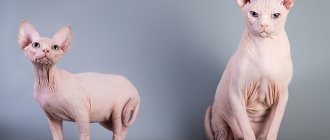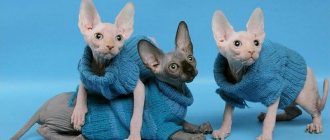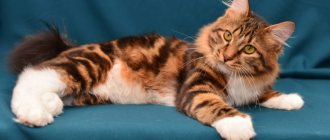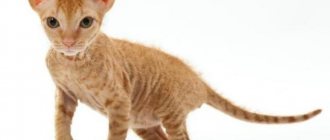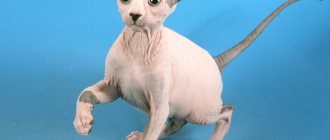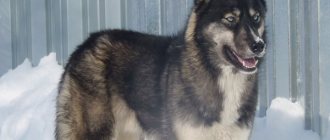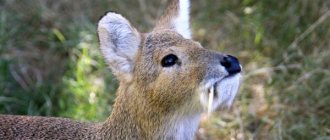History of the breed
Hairless cats were known to the Aztecs in Mexico. They differed from modern sphinxes in that they grew fur in the cold. However, by the 30s. 20th century completely disappeared.
The modern Sphynx breed developed in the 60s. 20th century. In Canada, a short-haired feline gave birth to a hairless cub. Breeders tried to breed similar naked individuals, but success did not come immediately, the offspring died. The acquired knowledge pushed scientists to further attempts at crossing; in 1985, Sphynxes were officially recognized as a separate breed with clearly defined standards. Initially, the Sphynx was called the “moon cat” or “bald Canadian.”
The hairless cat received the name Sphinx because it was similar to the cats of ancient Egypt, the drawings of which have survived to this day. In fact, there never was an Egyptian Sphinx.
The appearance of the Don Sphynx occurred in Rostov-on-Don in 1986. A resident of the city picked up a kitten, which she thought was sick - he was very bald. When the cat grew up and gave birth, it turned out that the kittens in the litter were bald. The birth of a new breed began with them. Donchak is a treasure of Russia due to its aboriginal origin.
The Petersburg Sphynx breed appeared in the northern capital in 1994. The Peterbald is a Donchak crossed with an Oriental cat.
Why are cats hairless?
global $ads_google;
//data-ad-slot=”2475549904″ $ads_google = empty($ads_google) ? false : true; ?> if ($ads_google == false) {?> $ads_google = true; ?> } ?> The mentioned cats Nellie and Dick turned out to be relatives, which is probably why the owner did not breed the breed, although he gave the animals a detailed description.
By the middle of the 20th century, information about the appearance of kittens without fur began to appear in the media from different countries.
It is believed that a kitten named Prune from North America became the ancestor of the Canadian Sphynx. The Don Sphynx was registered in 1998; the wonderful cat Varvara is considered the ancestor. It became clear that new
horizons for breeding cats. They began to actively breed hairless cats after the 80s of the last century.
A mutation led to the appearance of bald purrs in the world - thanks to this genetic failure, which is hereditary, the world saw new breeds of cats.
Comparison of Sphynxes by appearance breed standards
Sphynxes are medium in size, practically not exceeding 5 kg. The body is muscular, the skin is folded. Cats are not always completely hairless, covered with barely noticeable hair or fluff.
At the moment, breeders have bred three varieties of sphinxes, the name of which corresponds to the place of appearance. Let's present everything about the breed, as well as a comparison of the standards of each species:
- Canadian. The oldest representative, has existed since 1966. Weighs about 4 kg, while Sphynx cats are smaller than cats. There are no Canadians who are completely bald. There is fur on the tail, paws, muzzle, the length of the hair does not exceed 2 mm. But no mustache. The skin is very dense and folded to the touch. The muzzle is slightly elongated, there is a depression between the forehead and the straight nose. Distinctive features include defined cheekbones and straight, wide ears. The eyes are slightly slanted and shaped like a lemon. Mustaches may be missing.
- Donskoy. The largest representative, body weight reaches 7 kg. Kittens can be born naked, with velvet fur (“flock”) or with coarse fur (“brush”). By one or two years the animal is completely naked. The skin becomes smooth, folds are present, and with the onset of cold weather a light fluff forms. The head is neat, the cheekbones are clearly visible, the eyebrows are pronounced, like the body, and is covered with vertical folds. Fangs are visible under the upper lip. The ears are large, rounded, and protrude slightly forward. The nose is straight, the eyes are almond-shaped. The mustache is rounded or broken off.
- Petersburg (Peterbald). Petersburg cats are slightly smaller than other species, weighing about 3-5 kg. The body has short hair and is covered with folds. The head is wedge-shaped, wrinkled, cheekbones, and forehead are flat. It is supported by a thin, elongated neck. The ears are very wide, located at a great distance from each other. The eyes are small, almond-shaped, and come in green, blue or blue. The mustache is crooked or broken.
Bambino
Bambino is difficult to confuse with other sphinxes - an adult animal weighs no more than 4–4.5 kilos.
External characteristics:
- hair on the body of most bambinos is completely absent, but some individuals have barely noticeable hair;
- a cat's eyes can be yellow or green;
- large ears are located vertically;
- The hind legs are longer than the front legs.
There is a woolen tassel at the tip of the tail, and the pet’s body is small and elongated.
Difference from other breeds in temperament and habits
Despite their ambiguous appearance, Sphynx cats have a soft, easy-going character and are superior in behavior and breeding to most other breeds. These are not evil animals; there is no aggression in their nature. Thanks to their friendliness, they get along well with other pets. Many cats cannot live in the same house with dogs, but sphinxes are not afraid of them at all.
Bald representatives are socialized, do not hide from guests, and voluntarily participate in children's games. Cats have a very close relationship with their owner and need communication and attention. Even temporary separation from a person is not easy, resulting in apathy and depression.
Another difference in the temperament of a naked pet is the absence of predatory inclinations. The Sphinx is not interested in hunting, but is very fond of toys.
Sphynxes are an intelligent breed, easily potty trained, and follow their owner's commands. In the process of education, you cannot show physical force or aggression; it will be more effective to use a strict tone.
Elf
The Elf is an experimentally bred variety resulting from crossing the Sphynx and the American Curl.
Characteristics of an elf:
- medium-length nose with a small hump in the middle;
- rounded head and flat forehead;
- ears that widen towards the skull and have a vertical fold back;
- curled tail.
There is a small amount of hair on the tips of the ears, paws and tail. Elves, in comparison with other types of sphinxes, are larger in size - adult cats reach 6 kilograms, and male cats can weigh up to 8 kilograms.
The first kitten was recorded in 2007; to date, all the features of the subspecies have not yet been studied.
Features of care and maintenance
Lack of fur on a pet brings a lot of trouble. To keep your cat healthy, careful care is necessary, so some procedures are carried out daily.
To ensure that a purebred cat feels good, the following care measures are taken:
- Hygiene . Maintaining body cleanliness is the main and painstaking task of the owner. Due to the presence of sebaceous glands in a hairless pet, the skin is constantly contaminated, the areas in the folds are especially affected. Clean daily using a damp cloth or wet wipes. Sphinxes are bathed once a week. The ears are wiped with a special wind solution and examined for pathological contamination. To maintain healthy teeth, start brushing from an early age. For children, gauze wrapped around a finger is used; adults need a toothbrush and toothpaste. It is important to monitor the condition of your eyes. The absence of eyelashes makes this organ vulnerable to infectious lesions, so it is washed with saline once a day.
- Nutrition . Cats are big eaters, and if this process is not controlled, they may become obese. Sphynxes are fed according to a schedule, twice a day, avoiding snacks. If industrial feed is used, then it should be no lower than premium class. With a natural diet, chicken, turkey, veal, various cereals, low-fat dairy, fermented milk products, and chicken yolks are allowed. Any vegetables and fruits, to taste. With a balanced diet, additional vitamins and microelements are not required unless prescribed by a doctor.
Veterinarians do not recommend combining industrial food with natural food in the diet.
- Conditions of detention. Sphynx cats are very clean and meticulous about their place and litter box. The cat will not go to the dirty potty, but will do its business in a secluded corner. The breed is picky about air temperature and feels comfortable at 25 degrees. Some owners even buy clothes to keep their pet warm.
- Prevention of diseases. Despite strong natural protection, the Sphynx can get sick. The lack of fur makes them vulnerable to drafts and low room temperatures, which provoke colds.
Tray training
Training a Sphynx to use a litter tray actually begins from the first day. When the kitten is very small, the tray is placed in the place where he lives (sleeps, eats). The filler needs to be natural and small, as the baby may taste it. Small paws may not like large granules, and he may not want to go to the litter box.
You should watch the sphinx. If he gets worried and starts spinning around, it means he is looking for a place to go to the toilet, at which point he is carefully transferred to the tray. Sometimes the baby makes a puddle on the floor. In this case, you need to moisten a little filler in it and put it in the tray. Next time the kitten will find its toilet by smell.
How much do Sphynx kittens cost?
They buy purebred kittens from nurseries. It is advisable if the institution has a website that contains information about animals, photos, and customer reviews. The cost varies, depending on the variety, gender, and purpose of purchase. A cat for home can be bought for 10-30 thousand rubles, for mating the price tag is from 50 thousand rubles. Exhibition representatives have a good pedigree, their price reaches 300 thousand rubles. The cost of males is slightly less than females.
The most expensive type of Sphynx is the Canadian one.
When choosing a new family member, it is important to pay attention to the following criteria:
- the baby should be active, sociable, playful;
- upon examination, the integument is clean, the eyes are clear, there are no external lesions;
- kittens are vaccinated and have a veterinary passport.
Health
Modern Sphynx breeds have good immunity, although there are also sickly individuals. Like all cats, drafts are contraindicated for representatives of the breed. Sphynx diseases are often associated with their hairlessness. The absence of hair indicates that the breed is susceptible to colds, dermatitis, and acne.
Ringworm is the same common disease in the Sphynx, but due to its hairlessness it can be detected many times faster than in an ordinary cat. If a cat has spots on the skin, then only a veterinarian should determine the nature of their occurrence.
Since sphinxes love warmth, and their skin tends to tan in the sun, it is necessary to limit the animal’s exposure to the sun to avoid burns and heatstroke.
Risk items include hot radiators and heaters. By the way, the body temperature of sphinxes can reach a maximum of 39 degrees, but no more. Many owners unknowingly get scared, but there is no need to worry - this is a normal temperature for a cat.
Your pet's ears are susceptible to ear mites, so you should carefully monitor your pet's hearing.
Inversion of the eyelids in sphinxes or entropion occurs very often and occurs in a severe form. If treated incorrectly, the animal will lose its sight. If your animal's eyes are watery, you should seek help from a veterinary clinic. It is not recommended to prescribe medications on your own.
The health of sphinxes also depends on nutrition. If the feeding regime is incorrect, the pet may suffer from obesity or develop gastrointestinal diseases. The fat Sphynx is clumsy and overweight. Vitamins for sphinxes are very useful, but with proper nutrition the cat can do without them.
Vaccination of kittens should be carried out in accordance with the vaccination schedule. The first vaccinations for cats are given at 8 weeks, then at 12, and subsequent ones after a year.
How long does a sphinx live?
The average life expectancy of sphinxes is 10-17 years. With proper care and hygiene procedures at home, pets can live up to 20 years. There are precedents in history when the life expectancy of cats reached 30 years!
You can determine the age of a cat by the wear of its teeth. Around the age of 10, teeth begin to fall out.
Advantages and disadvantages
Hairless cats are popular all over the world. They are not only decorative animals, but also true loyal companions.
Studying everything about sphinxes, you can highlight the positive aspects:
- boundless love for the owner;
- cheerful, active, playful;
- do not damage furniture, wallpaper, things;
- clean;
- easy to train to the tray;
- contact with children, do not conflict with other pets;
- lack of wool in the house.
In addition to numerous advantages, the breed is also endowed with disadvantages:
- subtle mental organization, tendency to depression;
- require careful daily care;
- require unlimited attention, do not leave their owners;
- susceptible to colds.
Despite the fact that the Sphynx has virtually no hair, it is still not suitable for people with allergies. The fact is that a negative reaction of the body is provoked by the pet’s saliva and dust particles on the cover.
Hand Taming
If the sphinx has just been brought into the house, it needs time to adapt. These animals are very affectionate, and when the pet gets used to the hands, he himself will beg for affection.
Standard rules have been developed for accustoming a kitten to handling.
- When the kitten eats, it will feel sleepy. This is a good time to carefully pick him up.
- By talking to the kitten in a monotonous, affectionate voice, they achieve its relaxation. At this moment, the baby should be stroked a little behind the ear or on the neck.
- It is not difficult to lure your pet onto your lap with a treat, and when he begins to treat himself, you can lightly stroke him, but do not hold him by force.
- A baby who loves to play can be lured onto his lap with a toy.
Interesting facts about sphinxes
If you study Sphynx cats in more detail, you can tell several interesting facts about the breed that are not inherent in other felines. Funny features relate to both the physiology of the cat and its character:
- eat food using their front paws;
- no mustache, eyelashes;
- the body is hot to the touch, since the cat’s normal temperature is 39-39 degrees;
- are easy to train and know many interesting tricks;
- have sweat glands;
- love to swim;
- covers can be tanned;
- endowed with grace;
- the camera loves the Sphynx breed, the photos come out at the highest level;
- origin is based on genetic mutation;
- They prefer to sleep not in their own bed, but in a bed under a blanket with the owner.
Training
Sphynxes are not difficult to train, they are intellectuals, and they also strive to please their owner. By the age of 8 months, you can begin to teach your cat various tricks. Compliance with commands is reinforced with food. You need to observe what the animal likes. If he likes to run and jump, he can be taught to overcome obstacles on command. A cat that carries all sorts of things in its teeth can be easily trained to use the “fetch” command.
If it is difficult to establish contact with a cat, he shows aggression, he may need castration.
Diet
Animals that lack a layer of fur are forced to expend more energy to maintain a normal body temperature. For this reason, hairless cats should receive more high-calorie food. Basic recommendations for the correct selection of food:
- Avoid granules with high vitamin content. Such components are necessary for the beauty of the coat, but can cause harm to a bald cat.
- The diet should include a fairly large percentage of fat. Proteins with carbohydrates can remain at a basic level.
- When feeding natural products, you need to choose raw poultry and beef, boiled vegetables, meat, liver, and dairy products. The components can be crushed until smooth, added to soft foods, or given in their natural form, depending on the cat’s preferences.
Character
Sphynxes are friendly and sociable cats. They are ready to follow their owner's heels and meet him at the door. Sphynx cats, like ordinary representatives of the cat family, love games and toys - they will bring an abandoned piece of paper and run after an impromptu mouse, which children like. Cats get along well with all pets.
To help your cat remember its name faster, try to name it as simply as possible. You shouldn’t come up with tricky, unpronounceable nicknames, and let long generic names remain in the animal’s documents. If you don’t know what to name your pet, go to special sites where you can find a huge number of different cat names. Determine which one is right for your pussy and name it correctly.
Sphynxes are one of the smartest cat breeds. They are able to perceive and respond to commands. Their constant “freezing” forces the animals to look for a warmer place. This could be a blanket, the owner's lap, or the side of another pet. Let's look at the brief characteristics of the varieties of the Sphynx cat breed.
